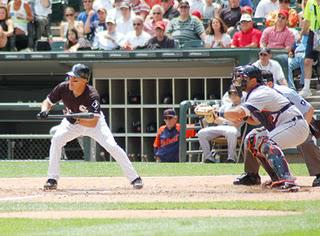NOTE: Tonight at 10PM (EST) I am participating in an online radio interview. The right side of the page below the microphone provides more details. Tune in!
A little while back I did a five part series of posts on the suicide squeeze. As I stated, I’m a big fan of the play but I do realize that the play can be risky. Many things on the offensive side have to be timed and executed correctly. Of course, anything that happens on the defensive side is out of your control. Pitch-outs, pitches in the dirt, etc. can all put a big damper on the success of the play.

A safety squeeze can be less stressful for batters,
runners, and coaches in certain situations.
In a safety squeeze, the runner on third base does not break towards home plate until he sees that the ball is bunted properly. In this case “bunted properly” means bunted in a location where the defense will not field it very quickly. This is why a safety squeeze is rarely used when the fielders are playing in on the grass to cut down the run. Any bunt in this situation is going to be fielded quickly. A normal squeeze play would be more effective here since the timing of the bunt plays more of a role than the placement of the bunt. In a safety squeeze, the placement becomes more important.
A good thing to look for when deciding to put on a safety squeeze is a first baseman who is playing back behind the base line at first base. If the batter can “push” the bunt towards first, it will take a while for the first baseman to get it. Therefore, if the runner on third sees the bunt directed towards first base, he takes off running towards home. If the ball is bunted poorly – right in front of the plate, popped-up, or right back to the pitcher – he just stays at third base. This type of timing also allows the runner to stay at third on any pitch-out, ball in the dirt, or any other missed bunt.
The downside to a safety squeeze is that runners need to exhibit good judgment in determining when to go. Of course, good judgment is not universal. Like anything else, practicing both ends of the play – running and bunting - generally leads to more understanding, confidence, and ultimately success.

